- Home
- Caring For Palms
- Outdoor Palm Care
Palm Tree Care Outdoor
Preparing to engage in palm tree care outdoors?
That's the best way to end up with a beautiful palm tree in your yard or garden! Caring for your outdoor palm tree is needed, but with variable tasks depending on the palm you have, or are choosing.
Here we'll guide you through key points of palm tree care in the outdoors. As a palm tree lovers ourselves, we want to help you grow that thriving tropic-like garden in your own front yard or backyard.
Feeling overwhelmed by so many palm trees?
You're not alone. We Understand your headaches! At Mission: Palm Trees you'll find clear answers to questions & Step-By-Step Guidance, from real people. With solutions to help. No puzzling shoptalk. No tiring research. So it's easy & fun for you.
Table of Contents
Click a button to choose which section to see, or just continue scrolling on down!
The Right Palm Planted in the Right Place
Yes, it really begins with choosing the right palm tree for your outdoor space.
Each palm species has its own climate & watering needs. Most palms don't have the ability to withstand climates far outside their Native Palm Origins.
 Arid Hardy Palms Like Growing Nearby to a River or Pond But Not IN the Water
Arid Hardy Palms Like Growing Nearby to a River or Pond But Not IN the WaterDesert Palms Not Enjoying Getting Inundated by a Flooding Nile River
Are You Outside of Zones Around the Tropics?
Do you typically get cold winters?
If so, you'll really want to know Those Cold-Hardy Varieties.
- Windmill Palms are one of the cold hardiest of all. They've been known to endure temperatures down to about -10°F/-23°C. Sometimes even lower!
- European Fan Palms are also a great choice. This clustering palm, when established, can survive down to 16°F/-10°C. Even below, but might Have Some Issues. But then it can revive itself!
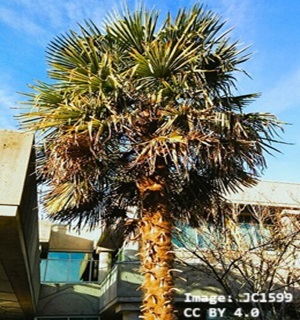 Trachycarpus fortunei - Windmill Palm
Trachycarpus fortunei - Windmill Palm Chamaerops humilis - European/Mediterranean Fan
Chamaerops humilis - European/Mediterranean FanFTC Disclosure: If you purchase via a link/ ad on this site, we may earn a small royalty. There's no added cost to you. Thanks much for any looks/ orders! Details>
Those are definitely an excellent choice for palms going through colder winters.
But still, sometimes cold-hardier palms may need specific protection. Know the approximate low temp limit for your palm species.
Watch if Extra Steps Will Be Needed to ward off cold damage.
If temperatures are expected to drop below your palm's tolerance level, consider helping with protection. By Wrapping Young Palms with a covering, Like Burlap or a Frost Cloth.
You can also try looping strings of White LED Lights around the palm. They can provide a little heat to for some extra warmth to help protect your palm. Please don't hammer nails or pins into your palm to hold them up, as the injuries can introduce disease.
But only use LED lights, to avoid overheating & fire hazards.
Tropical & Subtropical Zones are Easiest
If you live in a warmer type of climate, there's a much wider range of palms you can grow.
But considering the Right Palm in the Right Place is still essential. Like, we live in Zone 9b, but since we're In The Tucson Desert, we can't grow any palm we'd like.
For instance, the Everglades Palm is right for Zones 9b-11. It needs lots of watering into A Humus-Filled Soil. That won't work for us!
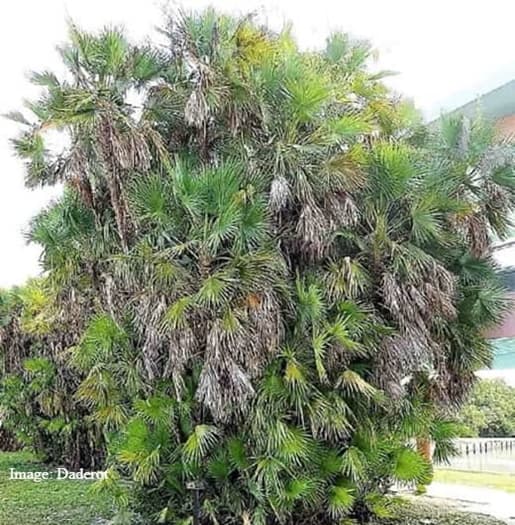 Acoelorraphe wrightii Does Grow in the Marshy Everglades
Acoelorraphe wrightii Does Grow in the Marshy EvergladesAnd The Majesty Palm is a popular choice for many. Good for USDA Zones 10-11. That's fine if you can give it lots of watering to keep its lush looks.
- It's near impossible to Overwater The Majesty Palm!
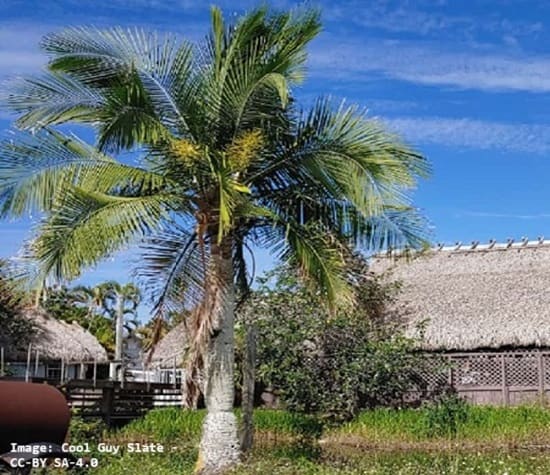 Ravenea rivularis: "I'm Still Thirsty - Give Me More Water!"
Ravenea rivularis: "I'm Still Thirsty - Give Me More Water!"Help in Choosing Your Palm
Are you ready to select your perfect palm? These may help:
- Planting a Palm Tree in Your Backyard>
- Or you'd like a focal point by having a Palm Tree in Your Front Yard>
- Before You Start Shopping or Planting it's a good idea to know the ins & outs of the good & bad!
Then it's time to think about Your Planting Needs for the best outcomes.
Your Palm's Care Needs
Now that you Know The Palm you're going to plant, there are tips to follow!
(Or Have You Already Planted?)
- Choose your planting area with that species' sunlight preference. Most do prefer full sun or partial shade. Be aware of exceptions.

- Most palms aren't too fussy about soil needs. But one thing is for sure, nearly all need well-draining soil. Most, though, don't do well in clay-type soils. You could help that with adding sand or Something Like Coir.
- When it comes to soil, you can have it tested for pH level and Needed Palm Nutrients, to ward off problems.
Water needs are more particular if your palm was just planted. They all need your regular watering during its first year. Still be sure the soil drain well. This watering schedule helps develop a necessary strong root system. Many roots were cut off or injured during transplanting into your yard.
After that initial successful year, it will be an established palm. Now's the time to adjust your watering schedule to your exact palm species needs. Also remember to adjust your watering schedule based on local rainfall.
What About Fertilizing Your Palms?
Fertilizing is something to think about when caring for your palm tree's outdoor care. Palms use nutrients from soil, but some soils are lacking. It's best to prevent nutrient problems, rather than treating them for nutrient problems.
To help you help your palm stay healthy, choose a totally slow-release fertilizer that's specifically made for palms. With the Correct Fertilizer Balance of nitrogen, phosphorus & potassium (NPK), plus added Magnesium. Added micronutrients also help.
Also remember that (this one here also tests soil moisture) Correct Soil pH is essential for palms to use these nutrients. That's why it's a good idea to know How Palms Grow to see if your soil needs testing.
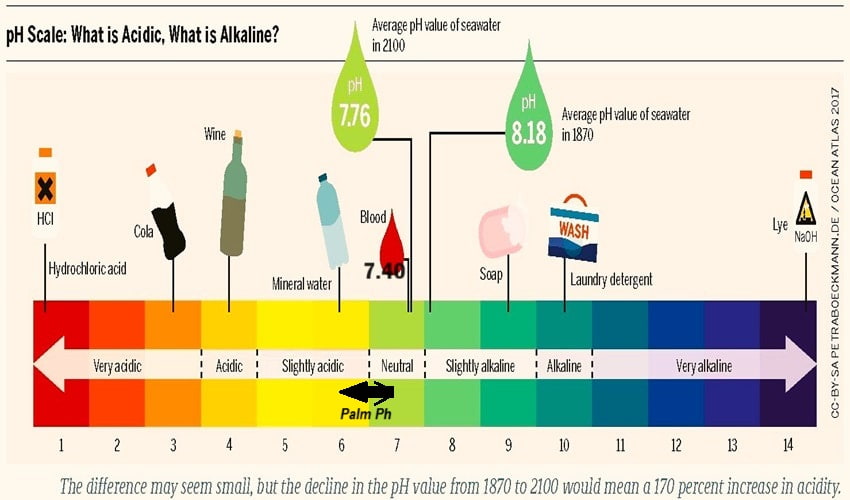 Best Palm pH is 6.0 to 7.0
Best Palm pH is 6.0 to 7.0Read the package instructions, but coordinate them with what's right for your palm. Rain, temperature (warmer is better for absorption), and of course soil type/pH affect nutrient uptake. So that means palms benefit from fertilizing every four months during the warmer months when it's growing season.
- Scatter the granules evenly under the trunk canopy, but away from trunk contact.
- Two types of fertilizers generally aren't recommended in your palm tree care outdoors:
- Liquid Fertilizer - It drains straight down into soil & may miss many uptake roots.
- Fertilizer Spikes - These also limit feed to which roots are nearby to use the nutrition.
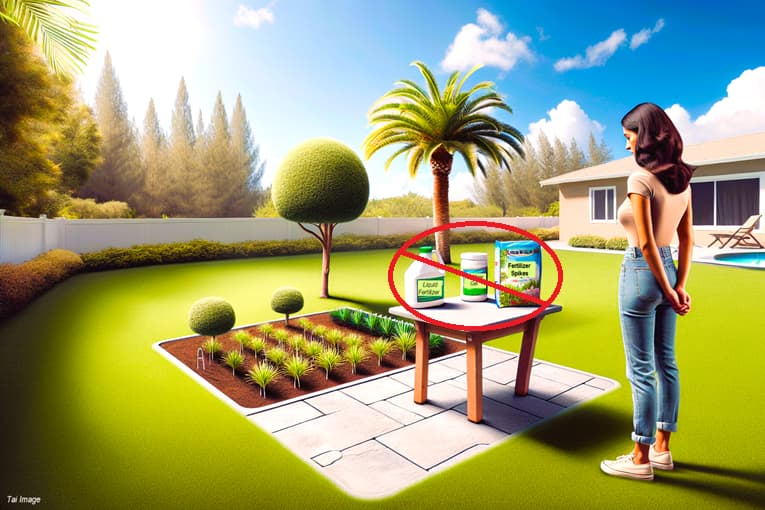 These Fertilizers Aren't Suitable For a Palm Nutritional Feed
These Fertilizers Aren't Suitable For a Palm Nutritional FeedTo Prune Your Palm or Not to Prune
As your palm tree grows, is Pruning Needed to keep it looking its best?
Once fronds are fully dead, trimming them off carefully is fine. If any green areas remain, they're still using active photosynthesis. Their food factory.
But removing totally dead palms can improve the palm's appearance.
Some Species of Palms Remove Fronds do their own self-pruning.
Over-pruning your palm isn't a good thing. As we said, keeping all green Parts of Fronds is beneficial for palm nutrition. There is a Best Practice for Pruning Palms, that will help your palm be sturdier and healthier.
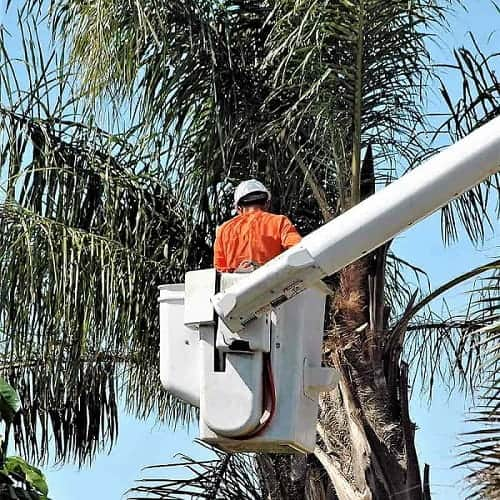 Still Many Green Fronds - Don't Remove Them!
Still Many Green Fronds - Don't Remove Them!If you live in an area with lots of palms, as we do, you'd have to note overambitious tree services cutting off too many fronds. All around Tucson, particularly in business landscapes we see this. We cringe every time!
They try to make palms look like sculptures or something. But it's a beautiful plant - not a sculpture.
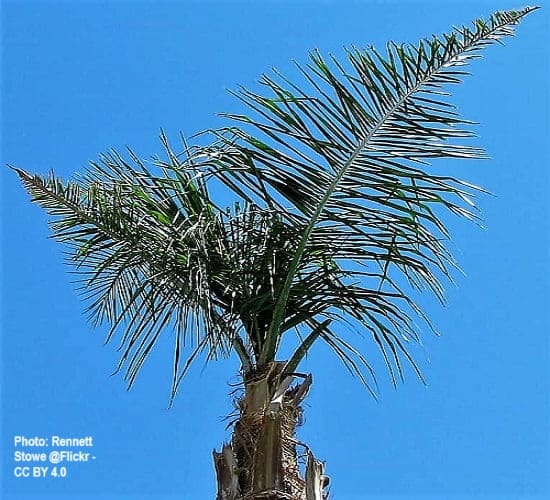 Depriving Palms of Photosynthetic Food & Looking Awful
Depriving Palms of Photosynthetic Food & Looking AwfulWorries about Pests & Diseases
The best way to handle Palm Pests or Diseases, is with prevention.
Look over your palm to notice any potential issues, as part of your palm tree care outdoor regular routine.
- Some species are particularly susceptible to attack by bugs.
- Diseases often enter the palm from trunk injury.
- Most common diseases that occur result from fungal attack.
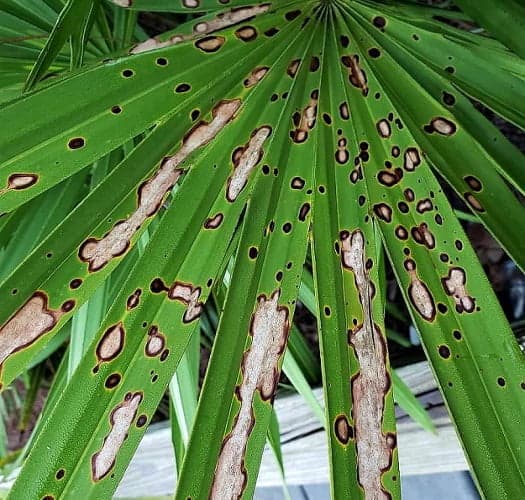 Leaf Spot Caused by Polaris Species of Fungus.
Leaf Spot Caused by Polaris Species of Fungus.Common palm pests include spider mites, mealybugs, and scale insects.
If you see signs like webbing or sticky residue on the fronds, Treat The Problem promptly. It's best to note when the signs first show up, to get ahead of the problem. Avoiding infestation, which can be difficult and overwhelming to solve.
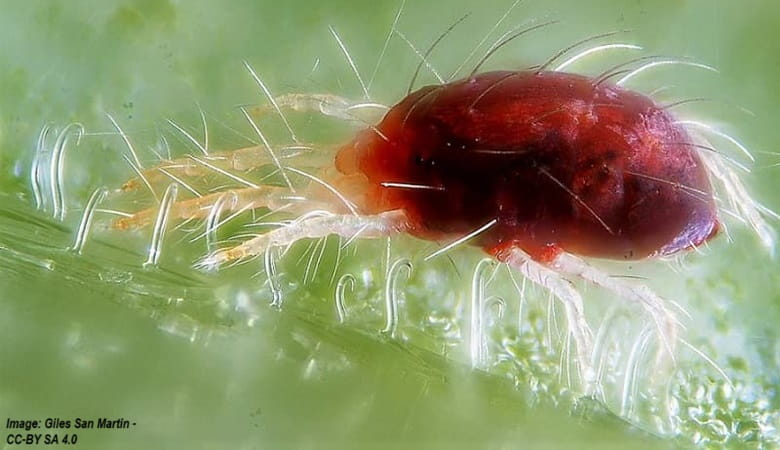 Spider Mites Leaving White Threads
Spider Mites Leaving White Threads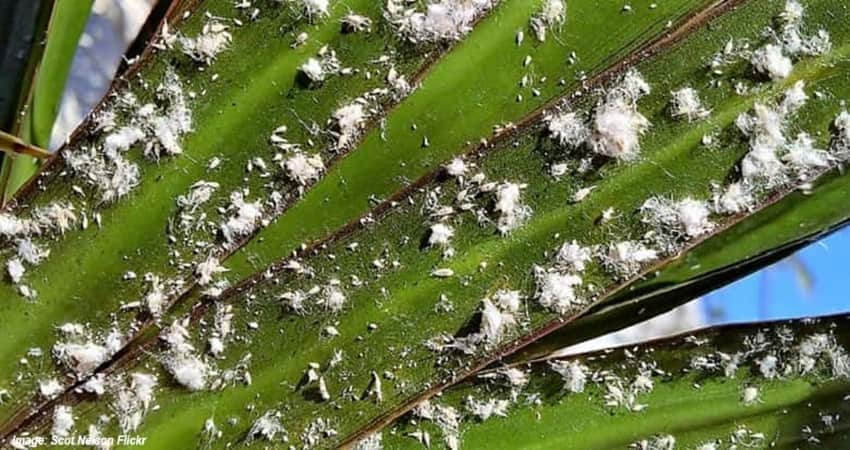 Sign of Mealybugs: White Sticky Cottony Patches
Sign of Mealybugs: White Sticky Cottony Patches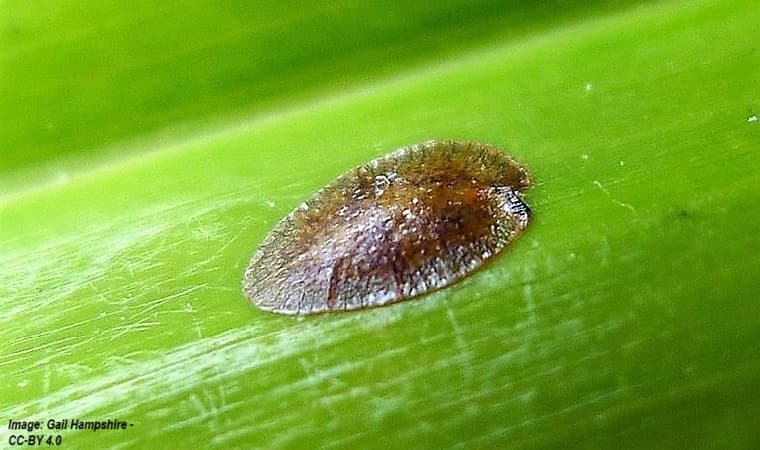 Scale Insect Attacking a Palm
Scale Insect Attacking a PalmTakeaways for Palm Tree Care Outdoor
Palm tree care outdoor means proper planting, watering, fertilizing, and prevention.
Follow guidelines to maintain attention for your palm's needs for good health. Caring for your palm tree can be a rewarding, enjoyable experience. You'll then have a stunning, healthy palm tree bringing you delight for years.
So go ahead and embrace the natural outdoors. Start your Palm Tree Care plan today!

